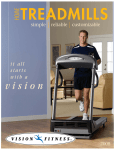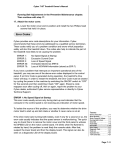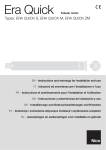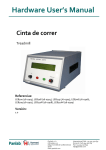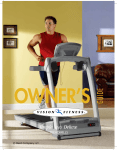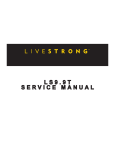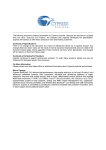Download Miele T9800HRT User's Manual
Transcript
Vision T9800HRT Service Manual 1 TABLE OF CONTENTS SECTION 1: MAINTENANCE PROCEDURE …………………3 1. 2. 3. 4. MAINTENANCE CHECK LIST………………………..............................4 TENSIONING THE BELT PROCEDURE………………………….……..5-6 DECK RE-WAXING PROCEDURE………………………………….……7 CLEAN THE GROOVES PROCEDURE…………….................................8 SECTION 2: WIRING DIAGRAM INSTRUCTION……………….9 1. 2. 3. 4. 5. 6. 7. 8. T9800(TM87) MCB WIRING(FOR 110V / 220V)………………………..10 T9800(TM87) MCB WIRING DEFINITION OF PIN…………...………..11-12 T9800(TM87) CONSOLE WIRING………………………………………..13 T9800(TM87) CONSOLE WIRING DEFINITION OF PIN……………....14-15 T9800(TM87) ELECTRICAL BLOCK DIAGRAM FOR 110V……….….16 T9800(TM87) WIRING DIAGRAM INSTRUCTION for 110V………..…17 T9800(TM87) ELECTRICAL BLOCK DIAGRAM FOR 220V..………….18 T9800(TM87) WIRING DIAGRAM INSTRUCTION for 220V…………..19 SECTION 3: CONSOLE FUNCTIONAL FLOW DIAGRAM……20 1. 2. OPERATION T9800 MANUAL…………………………………………….21 OPERATION T9800 MANUAL- Engineer mode……………………..…...22-26 SECTION 4: MCB LED INSTRUCTIONS……….……… …….….27 1. T9800 MCB LED PLACE AND DEFINITION…………………………….28-29 SECTION 5: TROUBLESHOOTINGS………………………………………30 1. 2. 3. 4. 5. 6. 7. 8. 9. 10. 11. 12. 13. T9800 Console Error code …………………………………………..……...31 E1 - Reverse Elevation Pot ………………………………………………….32 E2 – Elevation Out Of Range …………………………………………….….33 E3 – Elevation Stall ……………………………………….............…………34 E5 – Over-speed Error ………………………………...………………….….35 E6 – Runaway Belt Error …………………………………………..………..36 E7 – Speed Stall Error…...…………………………………………………...37 E9 – Speed Range Error …...…………………..…………………….……...38-39 Speed Issues .……………………………………………………..…………40 Belt Drive Issues………………………………………………………….…41 Speed Control Issues……………………………………………….……….42 Speed Calibration Issue……………………………………………..………43 2 OPERATION ERRORS…………………………...………………………...44 SECTION 1 MAINTENANCE PROCEDURE 3 MAINTENANCE CHECK LIST PREVENTIVE MAINTENANCE SCHEDULE Vision T9800 TREADMILL Item Daily Weekly Monthly Quarterly Console Mounting Bolts Frame Biannual Inspect Clean Power Cord Inspect Inspect Display Console Clean Handrail & Handlebar Clean Inspect Inspect Front Roller Clean Inspect Rear Roller Clean Inspect Clean Inspect Emergency Button Running belt Tension Test Inspect V Belt Deck Re-waxing Inspect & Re-waxing Running Belt Inspect Control Board Clean (Vacuum) Motor Annual Clean 4 TENSIONING THE BELT PROCEDURE Caution: Over-tightening of the roller will severely shorten the life of the belt and may cause further damage to other components. Frequency: Every 1 months Running Belt: If when you plant your foot on the belt, you can feel a slipping sensation then the belt has stretched and is slipping across the rollers. This is a normal and common adjustment on a new treadmill. To eliminate this slipping, tension both the rear rollers Allen bolts 1/4 TURN as shown above. Try the treadmill again to check for slipping. Repeat if necessary, but NEVER TURN the roller bolts more than 1/4 turn at a time. Perfect Tension of Running Belt: 0.9~1.1 lbs 5 Drive Belt: If you have tensioned the running belt and are still experiencing a slipping, adjust the tension screw. Then try the treadmill again to check for slipping. 6 DECK RE-WAXING PROCEDURE Caution: If deck is not to periodical add the waxing, between the deck and running belt will produce great friction make the deck and running belt to burn up and cut down the motor life . Frequency: Every 1 month Parts name: Silicon oil set Parts number: SZTM74SOS Price (USD): 0.6 Use time : 1 Procedure: 1. 2. 3. 4. 5. Loosen the tension bolts at both ends. Pull the belt with your left hand and apply the silicon in the deck with your right hand. (The volume of silicon applied is about 40ml) Tighten the tension bolts. Start the treadmill. Step on the treadmill belt to walk the silicon in. Adjust the belt tension if necessary. With the clamp-on meter, measure the current draw of the motor. (Clamp on either the red or the black wire.) The current should be less than 15Amps for 110V model. (less than 7.5Amps for 220V model.) 7 CLEAN THE GROOVES PROCEDURE Caution: If dirty grooves in the drive belt, motor and roller pulley, there will be noises while running. Frequency: Every 3 months Procedure: 1.Remove the drive belt and check the grooves in belt for dirt or dust and clean it. 2.Check the grooves in motor pulley for dirt or dust and clean it 3.Check the grooves in roller pulley for dirt or dust and clean it. 8 SECTION 2 WIRING DIAGRAM INSTRUCTION 9 T9800(TM87) MCB WIRING(FOR 110V / 220V) P7 P1 P6 J1 P4 J2 P3 P2 P7-------Motor wire P2--------SAFE SW (install software) P6------ on/off switch (power) J1--------RS232 (install software) J2-------Console cable P4--------Elevation cable P1-------Fan power P3--------Speed sensor (RPM) 10 T9800(TM87) MCB WIRING DEFINITION OF PIN JP1:Elevation cable(6pin/AMP-350762-4) 1 4 2 5 3 6 P4 Pin Name Definition 1 ELVR_+5V Incline place signal test power 2 ELVR_POT Incline place signal 3 ELVR_GND Incline place signal test ground 4 UP Incline motor does move to up 5 DOWN Incline motor does move to down 6 COM Incline motor does turn on power 11 J2: console cable 20 2 19 1 Pin Definition 1 Console ground 2 Motor Current 3 ELV REF GND 4 POT Wiper of ELV(0-5V) 5 ELV REF VOL.+5V 6 Speed. signal. (0-5V PULSE) 7 Console ground 8 Console ground 9 Console for MCB of the PWM signal 10 Console power 11 Console power 12 Console power 13 Console provide for incline motor UP signal 14 Console provide for incline motor DOWN signal 15 E_STOP 16 TX OUT(RESERVE) 17 RESERVE 18 RX IN(RESERVE) 19 ERR. SIG. 20 Console ground 12 T9800(TM87) CONSOLE WIRING J15 J16 J1 J14 J13-------Safety Pull Switch J11-------Safety Push Switch J5---------Main HR Interface J14-------Console cable J13 J11 J5 J15-------CSAFE 1 (Full csafe function) J16-------CSAFE 2 (Power only port) J1---------RS232 (install software) 13 T8900(TM87) CONSOLE WIRING DEFINITION OF PIN J14:20-pin console cable 19 20 1 2 J14 Pin Definition 1 Console ground 2 Motor Current 3 ELV REF GND 4 POT Wiper of ELV(0-5V) 5 ELV REF VOL.+5V 6 Speed. signal. (0-5V PULSE) 7 Console ground 8 Console ground 9 Console for MCB of the PWM signal 10 Console power 11 Console power 12 Console power 13 Console provide for incline motor UP signal 14 Console provide for incline motor DOWN signal 15 E_STOP 16 TX OUT(RESERVE) 17 RESERVE 18 RX IN(RESERVE) 19 ERR. SIG. 20 Console ground 14 J13: Safety Pull Switch J11: Safety Push Switch J13 J11 21 21 Pin Name Definition Pin Name Definition 1 SS OUT Safe key 1 SS OUT Safe key 2 SS IN Console ground 2 SS IN Console ground J5: Main HR Interface 3 2 1 Pin Name Definition 1 HR2 Pulse Board signal 2 VCC Console power (+5V) 3 GND Console ground 15 T9800(TM87) Electrical block diagram for 110V 16 T9800(TM87) WIRING DIAGRAM INSTRUCTION for 110V 17 T9800(TM87) Electrical block diagram for 220V 18 T9800(TM87) WIRING DIAGRAM INSTRUCTION for 220V 19 SECTION 3 CONSOLE FUNCTIONAL FLOW DIAGRAM 20 OPERATING T9800 21 T9800 OPERATION MANUAL- Engineer mode 1. Press & Hold both “ELEVATION ” and “SPEED ” at the same time for 5 sec. Then, the display will show “Engineering Mode ”. 2. Press the "ELEVATION UP or DOWN" to select you want and press the “SELECT" key enter. KEY BEHALE FUNCTION UP To scroll through the list of setting DOWN To scroll through the list of setting FAST Add this show parameter of speed SLOW Decrease this show parameter of speed SELECT To Store up the parameter Set the data/function Step. Use the elevation arrow keys to scroll through the available functions press “SELECT” key enter, press the “SPEED” key to choose the data press “SELECT” key to save the data/function. To exit, press “STOP” key 22 Engineering Mode Menu CONFIGURATION SYSTEM TESTS AUTO-CALIBRATION MANUAL CALIBRATION MAINTENANCE SOFTWARE VERSION EXIT CONFIGURATION Address Description Default Value Minimum Value Maximum Value P7 MAXIMUM TIME 99 5 99 P22 DEFAULT TIME 30 5 99 0:20 0:05 10:00 40 15 99 150 68 80 36 400 181 3 1 5 P6 T9800HRT English,0.5-12 Mph,15% Incline for USA P6 T9800HRT INT Metric,0.8-20 Kph,15%Incline for ID English,0.5-12 Mph,15% Incline for ID P6 T9800S English,0.5-12mph,15% Incline for USA P24 UNITS English/Metric P23 PAUSE TIME P27 DEFAULT AGE P8 DEFAULT WEIGHT English Metric P15 SCROLL SPEED P30 Maximum Speed English Metric P14 ELEVATION ERRS—OFF 12.0 20.0 ON Reset Novram EXIT Exits mode 23 MANUAL CALIBRATION Address Description Default Value Minimum Value Maximum Value P0 PWM MIN SPD PWM value at min speed (0.5 mph/0.8kph) 34 1 111 P1 PWM 1/2 MAX PWM value at 1/2 max speed (6.0 mph/10.0kph) 176 110 251 P2 PWM MAX SPD PWM value at max speed (12.0 mph/20.0kph) 341 249 486 P4 ELEVATION MIN Value at zero or minimum elevation 40 27 71 P5 ELEVATION MAX Value at maximum elevation 218 71 228 1 48 P13 ELV DIRECTION YES P19 MAGNET COUNT 26 P20 EFF DIAMETER 67.8 P21 PWM START SPD 30 1 ~ P29 RAMP TIME 30 12 40 EXIT Exits mode Remarks: Do not change the product below parameter , or it may cause malfunction. Address Default Value P13 ELV DIRECTION YES P19 MAGNET COUNT 26 P20 EFF DIAMETER P29 RAMP TIME 67.8 30 24 SYSTEM TESTS HARDWARE TEST DISPLAY TEST KEYBOARD TEST SAFETY SWITCH TEST IO TEST BURN-IN TEST ELEVATION BURN-IN TEST EXIT MANUAL CALIBRATION Address Description Default Value Minimum Value Maximum Value P0 PWM MIN SPD PWM value at min speed (0.5 mph/0.8kph) 34 1 111 P1 PWM 1/2 MAX PWM value at 1/2 max speed (6.0 mph/10.0kph) 176 110 251 P2 PWM MAX SPD PWM value at max speed (12.0 mph/20.0kph) 341 249 486 P4 ELEVATION MIN Value at zero or minimum elevation 40 27 71 P5 ELEVATION MAX Value at maximum elevation 218 71 228 1 48 P13 ELV DIRECTION YES P19 MAGNET COUNT 26 P20 EFF DIAMETER 67.8 341 P21 PWM START SPD 30 1 ~ P29 RAMP TIME 30 12 40 EXIT Exits mode 25 MAINTENANCE Address Description Default Value Minimum Value Maximum Value P9 Total HOURS 0 0 6533.5 P10 TOTAL DISTANCE 0 0 65335 P25 BELT/MOTOR HOURS 0 P26 LIFT MOTOR HOURS 0 P16 LUBRICATE DECK MSG OFF P17 CLEAN 0 TREADMILL MSG 0 ERROR LOG 0 EXIT Exits mode Remarks: If you want to the clean below parameter, please enter engineering mode select “below place” enter, hold “START” key for 3 sec. P9 Total HOURS P10 Total DISTANCE P25 Belt/Motor HOURS P26 Lift (Elevation) HOURS P16 LUBRICATE DECK MSG P17 CLEAN MSG TREAMILL MSG Error Log 26 SECTION 4 MCB LED INSTRUCTIONS 27 AC FAN 28 LED STATUS Reference Designator Description LED 1 Auxiliary Status LED LED 2 Auxiliary Status LED LED 3 Auxiliary Status LED LED 4 Auxiliary Status LED/Digital to Analog Output. LED 5 Main Status/Error LED. AC LED 6 Indicates if the DC Buss is Energized (Voltage Present). +VCON LED 7 Indicates if Console Voltage Supply is present. VDSP LED 8 Indicates if the DSP Power Supply is present. DOWN LED 9 Indicates if the upper console is commanding Elevation DOWN. UP LED 10 Indicates if the upper console is commanding Elevation UP. PWM LED 11 Indicates if Console is commanding speed. SPEED LED 12 Indicates the motor is moving via the encoder's feedback by blinking. NORMAL OPERATION 1. LEDs 1, 2 and 3 Sequence back and forth to indicate the processor is on-line and operational. 2. LED 4 is used as a discrete/analog signal to the upper console. 3. LED 5 indicates system status/mode. Currently 3 modes are defined safe mode, stand-by mode and run mode. They are defined as follows: a) Safe Mode - When the controllers safety relay is not energized and no error exists, LED 5 remains off. b) Stand-by Mode - When the safety relay is engaged but the system is not outputting an active PWM to the motor and no error exists, LED 5 blinks off and on at a fast rate. c) Run Mode - When the system outputs an active PWM Control signal to the 29 motor and no error exists, LED 5 remains ON. SECTION 5 TROUBLESHOOTINGS 30 T9800 Console Error code CODE DESCRIPTION E1 Reverse elevation pot E2 Elevation out of range E3 Elevation movement stall E5 Over-speed E6 Runaway belt E7 Speed stall (could be missing speed sensor) E9 Speed Range (usually caused by calibration) E16 Stuck key error E18 Safety Switch Test Failure E19 NOVRAM failure Movement related errors can be divided in elevation related errors (E1 – E3) or speed related errors (E5 – E9). Elevation Errors (E1 – E3) Movement Errors Speed Errors (E5 – E9) System Errors Operation Errors 31 E1 - Reverse Elevation Pot Step 1. Calibrate Elevation Calibrate the elevation as outlined in the System Calibration Procedure in below step. Error 1 Enter engineer mode of “MANUAL CALIBRATION” screen Check the “P13 ELV DIRECTION” screen whether set to “Yes” Set to “Yes” Enter the “P4 ELEVATION MINIMUM” screen whether parameter set is 30 2 AUTOCalibration Enter the “P5 ELEVATION MAXIMUM ” screen whether parameter set is 240 5 AUTOCalibration AUTOCalibration Step 2. CORRECTIVE ACTION 1.Ensure correct signal is being sent to interface board (MCB) by pressing elevation up/down keys by observing elevation LED’s correctly corresponding to correct elevation keys pressed (please refer the 29 page) . If failure occurs for this step check console cable and then the interface board (MCB). 2.Check failed elevation motor, interface board, console cable with a known good console. 32 E2 – Elevation Out Of Range Step 1. Calibrate Elevation Calibrate the elevation as outlined in the System Calibration Procedure in below step. Error 2 Enter engineer mode of “MANUAL CALIBRATION” screen Check the “P13 ELV DIRECTION” screen whether set to “Yes” Set to “Yes” Enter the “P4 ELEVATION MINIMUM” screen whether parameter set is 30 2 AUTOCalibration Enter the “P5 ELEVATION MAXIMUM ” screen whether parameter set is 240 5 AUTOCalibration AUTOCalibration Step 2. CORRECTIVE ACTION 1.Check the failed system with a known good console cable. If fixed then repair/replace the console cable. 2.Check the failed system with a known good elevation motor. If problem fixed then repair/replace the elevation motor. 3.Check the failed system with a known good interface board. If problem fixed then repair/replace the interface board (MCB). 4.Check the failed system with a known good console board with current software. If the problem is fixed then repair/replace the console. 33 E3 – Elevation Stall Step 1. Please refer the below PROBLEM IDENTIFICATION Step. E3 Error Check the “P13 ELV DIRECTION” screen whether set to “Yes” AUTOCalibration Set to “Yes” Enter Hardware Test Screen Run Elevation Up And Down Treadmill moves up or down? N Motor Overheated? Waiting the Elevation Motor to cool N Y Feedback Changes Elevation Y Motor Movement Issue Y AUTO-Calibration N Position Feedback Problem Step 2. CORRECTIVE ACTION 1.Allow elevation motor to cool. 2.Check the failed system with a known good console cable. If fixed then repair/replace the console cables. 3.Check the failed system with a known good elevation motor. If problem fixed then repair/replace the elevation motor. 4.Check the failed system with a known good interface board (MCB). If problem fixed then repair/replace the interface board (MCB). 5.Check the failed system with a known good console board with current software. If 34 the problem is fixed then repair/replace the console. E5 – Over-speed Error OVERVIEW If the actual speed from the speed sensor exceeds the system maximum speed by a limit (currently 2 MPH) an over-speed error occurs (E5). Step 1. AUTO CALIBRATION AUTO-Calibration the as outlined in the System Calibration Procedure in below step. Error 5 Enter engineer mode of “AUTO CALIBRATION” Please will start Key held for 3 seconds to auto calibration Measured speed < 14 MPH & displayed speed > 14 MPH Speed feedback issue Speed control issue Speed Feedback Issues – See speed feedback issue trouble shooting guide in the CORRECTIVE ACTION PROCEDURES – Speed Issues section of this document. Speed Control Issues – See speed control issue trouble shooting guide in the CORRECTIVE ACTION PROCEDURES – Speed Issues section of this document. Step 2 : 1.Record when parameter information with error (please refer the 25 page of P1 / P2 / P3 place) . 2.Remove Power!!! Carefully check all connections. 3.Check interface board (MCB) with the speed sensor ensure contact are correct and fix. 4. If AUTO CALIBRATION can't finish, please take speed sensor to be close to magnet and AUTO CALIBRATION again. 5.If repeat over speed errors occur remove the treadmill from service. 35 E6 – Runaway Belt Error OVERVIEW If the actual belt speed is greater than the target speed by a limit and increasing then an E6 error is called. E6 errors flag errors that will result in the belt “running away” or not responding to input. Step 1 : Error 6 Before cycling power inspect the motor controller for error conditions Motor Controller Error Record error code information from motor controller Record console error code parameters recorded with current error code Inspect all electrical connections, ensure that all connections are properly made and there are no shorts to adjacent conductors Speed feedback issue Speed control issue Speed Feedback Issues – See speed feedback issue trouble shooting guide in the CORRECTIVE ACTION PROCEDURES – Speed Issues section of this document. Speed Control Issues – See speed control issue trouble shooting guide in the CORRECTIVE ACTION PROCEDURES – Speed Issues section of this document. Step 2 : 1.Remove Power!!! Carefully check all connections, interface board and the Reliance Motor controller setting to ensure all settings are correct. 2. Enter the engineer mode to SERVICE 5, press "START" key to clean "ERROR LOG" and refer the T5x Engineer mod parameter set SOP to confirm the machine parameter whether is correct. 3. AUTO CALIBRATION again. 4. If AUTO CALIBRATION can't finish, please take the speed sensor to be close to magnet and AUTO CALIBRATION again. 36 E7 – Speed Stall Error OVERVIEW If no belt movement is detected several seconds after commanding belt movement a speed stall error (E7) is called. Step 1 : E7 Error Enter firmware setup screen Start PWM 1/2MAX test N Belt Moving Belt drive issue Y Allow belt speed to stabilize and measure belt speed Y Measured speed different than displayed speed Speed Feedback Issue N Measured speed = 6.4 MPH N AUTO CALIBRATION Y Displayed speed = 0 N AUTO CALIBRATION Y Speed feedback missing Step 2 : Belt Drive Issues – See belt drive issue trouble shooting section in the CORRECTIVE ACTION PROCEDURES – Speed Issues section of this document. Speed Feedback Issues – See speed feedback issue trouble shooting section in the CORRECTIVE ACTION PROCEDURES – Speed issues section of this document. Speed Feedback Missing Issues – See speed feedback issue trouble shooting section in the CORRECTIVE ACTION PROCEDURES – Speed Issues section of this document. 37 Calibration Issues – See speed calibration issue trouble shooting section in the CORRECTIVE ACTION PROCEDURES – Speed Issues section of this document E9 – Speed Range Error OVERVIEW During normal run time operation the value stored during auto calibration is used to initially set the speed (e.g. target speed = 12 MPH, PWM ticks = Maximum PWM = 363). Once the speed stabilized the actual speed is monitored and if different than the target speed the PWM value is adjusted until the actual speed matches the target speed. If the PWM value is changed by more than the amount of ticks required to change 0.8 MPH and the actual speed does not match the target speed then an E9 error is flagged. This error indicates the motor controller system is unable to maintain the target speed. E9 Error Before cycling power inspect the motor controller for error Y Motor controller error Record the error code from the motor controller Check for free movement of belt roller movement Cycle Power Run auto calibration Done N Start PWM ½ MAX test Measure speed and compare to value displayed in time window N OK Perform steps outlined in speed feedback issue Y Run Auto Calibration N Error Gone Perform steps outlined in speed control issue Y Done 38 Speed Feedback Issues – See speed feedback issue trouble shooting section in the CORRECTIVE ACTION PROCEDURES – Speed Issues section of this document. Speed Control Issues – See speed control issue trouble shooting guide in the CORRECTIVE ACTION PROCEDURES – Speed Issues section of this document. Calibration Issues – See speed calibration issue trouble shooting section in the CORRECTIVE ACTION PROCEDURES – Speed Issues section of this document. 39 CORRECTIVE ACTION PROCEDURES – Speed Issues Speed Feedback Issue Perform steps in order listed until problem resolved. 1. .Check connections 2. .Check magnet orientation (correct poles) 3. .Check sensor mounting 4. .Replace sensor w/ known good sensor 5. .Replace interface PCB with known good PCB Enter Magnet Count screen N Magnet count = treadmill # of magnets Adjust magnet count to match number of magnets Re-run test Y Manually rotate belt and check for only 1 speed pulse on interface board per magnet (check all magnets) N N OK? Enter effective diameter screen of firmware setup Pulse only one magnet Y Y Perform steps in order listed until problem resolved. 1. Check connections 2. Check magnet orientation (correct poles) 3. Check sensor mounting 4. Replace sensor w/ known good sensor 5. Replace interface PCB with known good PCB Setup effective diameter as described in system calibration section of this document N N No pules for either magnet Perform steps in order listed until problem resolved. 1. Check magnet orientation (correct poles) 2. Check sensor mounting 3. Replace sensor w/ known good sensor Multiple pulse per magnet Y Perform steps in order listed until problem resolved. 1. If reed type sensor replace with Hall type sensor or correctly orient sensor. 2. Check connections 3. Check sensor mounting 4. Replace sensor w/ known good sensor Y Problem Fixed N Perform steps in order listed until problem resolved. 1. Check connections 2. Check magnet orientation (correct poles) 3. Check sensor mounting 4. Replace sensor w/ known good sensor 5. Replace interface PCB with known good PCB 6. Replace console PCB with know good PCB Re-calibrate system Done 40 CORRECTIVE ACTION PROCEDURES – Belt Drive Issues Belt Drive Issue Start PWM max test (firmware setup screens), wait 20 seconds Check PWM LED on interface PCB N PWM LED illuminated Perform steps in order listed until problem resolved. 1. .Replace ribbon cable with known good ribbon cable. 2. .Replace interface PCB with known good interface PCB. 3. .Replace console PCB with a known good console PCB. Y Perform steps in order listed until problem resolved. 1. .Ensure belt and drive is able to turn freely and are properly mechanically connected. 2. .Check all electrical connections 3. .Verify reliance drive settings 4. .Replace ribbon cable with a known good cable 5. .Replace interface PCB with a known good PCB 6. .Replace console PCB with a known good PCB 41 CORRECTIVE ACTION PROCEDURES – Speed Control Issues Speed Control Issue Start PWM max test (firmware setup screens), wait 20 seconds or until speed stabilizes N See belt drive issue Belt moving Y Measure speed and compare to value displayed in time window N OK Speed feedback issue Y Run Auto Calibration (firmware setup) Problem Fixed Y Done N Perform steps in order listed until problem resolved. 1. .Ensure belt and drive is able to turn freely and are properly mechanically connected. 2. .Check all electrical connections 3. .Verify reliance drive settings 4. .Replace ribbon cable with a known good cable 5. .Replace interface PCB with a known good PCB 6. .Replace console PCB with a known good PCB 42 CORRECTIVE ACTION PROCEDURES – Speed Calibration Issue Speed Calibration Issue Run auto calibration (firmware setup screen) Y Auto calibration passed Done N Start PWM max test (firmware setup screen), wait minimum 20 seconds or until sped stabilizes Measure speed and compare to value displayed in time window N OK Check speed feedback issue Y Check speed control issue 43 OPERATION ERRORS E16 – Stuck key error OVERVIEW If a key press is detected for more than 45 seconds a stuck key error is flagged. This error is primarily caused by a faulty keypad but could be caused by other issues (object on the keypad). CORRECTIVE ACTION Reset system power. If error re-occurs replace the keypad with a known good keypad. If error still occurs replace console PCB with known good console PCB. E18 – Safety switch test failure OVERVIEW If the actual speed exceeds limit set for safety switch test a safety switch test failure error occurs.. CORRECTIVE ACTION Re-calibrate system as listed in system calibration section of this document and re-run safety switch test. If system still fails safety switch test run speed feedback issue and speed control issue tests in the corrective action procedures section of this document. E19 – NOVRAM Failure OVERVIEW If the values stored in non-volatile memory are out of limits or do not match the safety check value stored in non-volatile memory a NOVRAM failure occurs. The system attempts to reinitialize the non-volatile memory three times and if the NOVRAM check fails all three attempts a NOVRAM failure error (E19) is called. CORRECTIVE ACTION An E-19 error indicates the NOVRAM has critically failed and needs to be replaced. If an E19 error occurs the console should be reprogrammed with the current software version and the power should be toggled. If this does not clear the E-19 error the console PCB will need to be returned to DCI for repair. 44












































